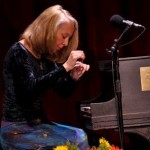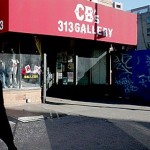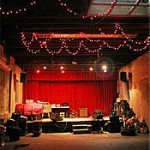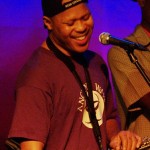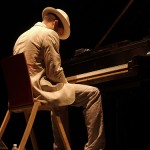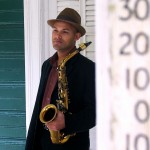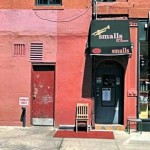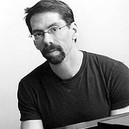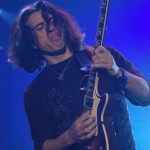 I came out to hear somebody else, I can’t remember who. This was November of 2011, at Smalls. There were two bands on deck, two sets apiece. Somebody must’ve called in sick, or maybe the second band just asked the bassist to stick around, because she ended up playing all four sets. The old jazzhead sitting next to me wondered aloud if she was the house bass player. That’s all I remember—that, and the last-set bass solo. When it was over, and we got done clapping, we looked at each other as if to say, OK, and where the hell did she come from?
I came out to hear somebody else, I can’t remember who. This was November of 2011, at Smalls. There were two bands on deck, two sets apiece. Somebody must’ve called in sick, or maybe the second band just asked the bassist to stick around, because she ended up playing all four sets. The old jazzhead sitting next to me wondered aloud if she was the house bass player. That’s all I remember—that, and the last-set bass solo. When it was over, and we got done clapping, we looked at each other as if to say, OK, and where the hell did she come from?
*
Where indeed? Born in Malaysia to parents of Chinese descent, raised in Perth, but that’s hardly an answer. In a global era, for a global music, Perth may just be the new Kansas City, Kuala Lumpur the West Coast. Still and all, rivers always reach New York. And so did she.
I think the pianist Vijay Iyer put it best: “I love the way she just blew into town and took over.” A year and a half ago I’d never heard of her; now, Linda Oh is hard to miss.
*
As so often happens, I lost touch with Oh for a few months after the Smalls show. She became just that amazing female Asian bass player, not to be confused with the other great female Asian bass player who gigs at Pisticci on Sunday nights (really, how many can there be?). And then, twice in March of ‘12, two very different trios: Fabian Almazan’s at the Vanguard, and Oh’s own at the Rubin museum. Almazan is easily my favorite of the four young pianists spotlighted by Ben Ratliff in his Times article last year. Here, though, I wanted to focus on the Rubin set, and Oh’s first record, Entry, both of which feature Ambrose Akinmusare on trumpet.
From the opening bass strums and trumpet mewls of “Morning Sunset” to the Red Hot Chili Peppers cover for a closer, it’s hard not to hear echoes of the bass-led power trios I whetted my young ears on before coming to jazz. Today, it’s as easy to hear Roy Campbell’s Pyramid Trio, or the early electric Miles. Entry is a raw, heavy, tough, spare record, riff-based and rhythmically-driven, with a feel of bleak avenues and endless rooftops: music for a traveling cityscape, mournful but not without humor, homeless but never rootless, graspingly beautiful. Oh plays with a calculated heaviness, bellyflopping on low notes, slapping those fat strings, letting them hum and buzz. She doesn’t do much walking; when she finally does, at the end of “201,” just a track shy of the end, it’s more swagger than swing. There’s a gangly quality about the playing, too, a rough-and-tumbleness, as if we were waiting for the musicians all to collapse together in a heap.
The songs offer a pretty open terrain to improvise on, and at the Rubin set, as on the record, Akinmusire took full advantage, playing against the grain of the bass, missing high-note climbs by a note before careening back down, skittering into a solo and then backing off with a whine. He liked to fiddle with dynamics—bright, sharp cries and bugle calls followed by long, breathy interludes—his horn less an extension than a purer embodiment of his voice. As for Oh, it’s hard to know where to begin. Watching her play is half the fun; she’s so physically in tune with the music she’s creating that the instrument transforms her. Such a wealth of ideas, such a mastery of the bass’s rich vocabulary of harmonics, taps, strums and slides, and such a happy gift for melody and phrasing—each is rare enough in itself; to find them all together, and in a player so young, seems almost unjust.
Like the album, the set ended with “Soul to Squeeze,” the Chili Peppers ballad, actually a B-side from Blood Sugar Sex Magic. A friend of mine, a great writer, once said that the most affecting moments in fiction are the sort that take the reader by surprise—and very often, the writer as well. Something like this happened at the Rubin set with the Chili Peppers song. I’m not accustomed to being moved in this way by jazz. Exalted, excited, intellectually stimulated, sure. Once, though, I saw George Benson sit in as a vocalist during a Ron Affif set at the Zinc bar, this back in the ‘90s when the Zinc was on Houston and those Monday night jams had become a magnet for New York’s jazz Illuminati. He sang just one song, “All of Me,” and before I knew it there were tears in my eyes. It had nothing to do with the words, or the melody, or emotion per se, as it would with, say, a pop ballad, or a folk song, or a Chopin nocturne. It was rather a sense of presence, of contact, or the momentary revelation of the ideal in the guise of the real, like an avatar. True, “Soul to Squeeze” is a pop ballad; but I think the feeling on this night arose from something closer to the Benson experience. Oh started out with a pensive solo, really embellished statements of the melody, although this only became clear as the solo drew to a close. Then the horn, gently rising. It was like Oh’s bass had opened a door, and Akinmusire’s horn stepped through. An ease of walking, a lightness of step, as if answering some unheard call in the opening couple of bars of bass. They could have stopped there; nothing else needed to be said. You hear this, and the title of Akinmusire’s Blue Note debut, When the Heart Emerges Glistening, seems anything but corny. You want every band to do what they did.
When the set ended, someone from the museum came up and hung white stoles around each of the musicians’ necks, which was itself weirdly moving, and so fitting after the last song, blessing them for the blessing they’d brought us.
While I was waiting to pick up a copy of Oh’s new album Initial Here, a couple of music students, probably high school age, were noting to each other (in tones of disapproval) that all the tunes were modal, with none of those tricky bop changes to keep the musicians on their toes, and dissuade amateurs from the bandstand. They were wondering aloud whether she could really play changes—dare I say “keep up with the boys”? I wanted to turn to them and say they should have heard her at Smalls. (In Miles Davis’s gruff whisper: “She can play those changes like a motherfucker.”) A decade from now, after she’s won a Grammy and has a dozen albums under her belt, they’ll be talking about how they saw her when they were eighteen, when they used to have that Friday night music series at the Rubin, before anyone really knew who she was, and with Akinmusire, too, no, dude, I’m not shitting you, really, they used to play together, I’ll burn you her first album. And the younger musicians will regard them with awe and reverence.
It turned out she was hawking her own records. I had to ask her three times what the title of that ending song was; I’d only listened to Entry once at that point, and would only make the connection between the tune and the record later on. Either I couldn’t hear her, or it was the Perth accent; but the third time I asked, she signed it for me: “Soul,” she said, and made some sort of gesture I can’t remember—maybe put her hand on her heart?—“to squeeze”—and she hugged herself, briefly. Now, I have spoken to a fair number of musicians, and the majority have warm personalities, and seem like the sort of people you’d have over for dinner, open a bottle of wine with, maybe even let the conversation wander into politics. They might squeeze your shoulder, as Bob Stewart did mine the other day, big hands of a tuba player, if not your soul. But this exchange was special. She could have said it louder the third time, with that edge of annoyance that greets the tourist who doesn’t know when to stop asking and just smile. Instead, she treated me with the cheerful patience due an elderly ward. I’m not sure what this says, but I know it’s the opposite of bad.
*
By the time I caught Oh again, with her quartet at the Jazz Standard in June, I’d had a few chances to listen to Entry, a few less to Initial Here, the record she was supporting this night. They are as different as the show at the Standard would prove to be from the Rubin, and as both were from Smalls. If Entry is a fledgling, fusiony romp, weighty and starkly beautiful, Initial Here is remarkable at once for the deftness with which it captures the contemporary jazz idiom—Dave Douglas’s quintet comes to mind, as does Dafnis Prieto’s—and for the breadth of styles, rhythms and cadences it exhibits—from the bluesy Ellington spiritual “Come Sunday” to the Sturm-und-Drang drama of “Deeper Than Sad,” the jaunty Caribbeanisms of “Desert Island Dream” and the seemingly cadenceless and deeply moving “Thicker Than Water,” featuring the preternatural vocals of Jen Shyu. In fact, Shyu serves to remind us how much this record, as much as Entry, bears the mark of all the players in the band—and the collective musicianship here is pretty phenomenal. Each track is a surprise; the riches stretch end to end, like pearls on a string.*
What was most remarkable about the Standard set, though, was not just the opportunity to hear Oh in yet another creative format, but to hear the growth of one tune in particular. Called “Ten Minutes to Closing,” the title reflects the commission that comes as part of the invitation to perform at the Rubin: the musician composes one tune about a piece of art at the museum. As Oh told it at the Rubin, she only found one at the eleventh hour, so to speak—necessity being the mother of invention; and so the tune is less about the piece itself than about the artist’s struggle to create on demand. Perhaps the tune was trying capture that feeling of contingency and indecision. If so, it tried too hard; the changes felt forced, the structure ungainly. It was the only tune in the Rubin set that fell flat, leaving me wondering if it was still under construction, an inspiration arrived at too late.
At the Standard set, “Ten Minutes” came second, right after the hoppy opener “No. 1 Hit.” It had obviously been worked over since the Rubin: very recognizably the same tune, with the same flippant tone and quirky changes … but in every other way, different. Somehow, the arrangement for quartet had welded it into a whole. I’m looking forward to hearing how it sounds recorded.
It was nice to see the electric bass come out for an extended cooker, certainly the jam of the evening, a side of Oh that appears on Initial Here, but which I had not had a chance to witness live: that elixir of Riot Grrrl, Jaco and Flea that couldn’t but push the already-bursting energy of the night another notch higher. And yet, “10 Minutes” was the tune I remember best, because it presented the opportunity to watch the music grow, and the musicians with it. I’ve somehow gotten to the age—it’s definitely snuck up on me, like those tears—where a lot of the musicians I go hear are younger than I am. They’ve become like the kids in some fantastic musical neighborhood, all moved out and making good, and my seat at the club, or maybe the virtual one in the Pit, the porch swing from which I watch history go by. Remember Linda from down the street? Yeah, she’s all grown up and playing music in New York. Making quite a name for herself, too. And Ambrose! Remember Ambrose? Well …
*
I guess I’ve been writing a jazz Horatio Alger story of sorts, or maybe a David Levinsky (remember, he’s the one who wanted to be Irving Berlin), tracing this young immigrant musician’s rise from the good company of her similarly-emerging peers to Soundprints, the supergroup featuring Dave Douglas and Joe Lovano and Joey Baron, at the Vanguard almost exactly a year from that night I first caught Oh at Smalls. By now I was a certified Oh junkie, waiting out in the cold an hour for my fix, for the proverbial man. I stood in front of that red door so long people started thinking I worked there, and I even came to enjoy playing the part, holding the door, answering questions—why I wasn’t taking money is anyone’s guess. About twenty minutes into the queue, a couple of music students from NYU joined me—they always seem to come in pairs, like missionaries—good people to shoot the breeze with while the wind cut through our coats and all those who’d thought far enough ahead to make reservations glided past. At 9 o’clock, the VV staff grudgingly found us seats, me at the absolute and utter rear of the club, back against the wall, band visible over a sea of heads, waiters milling in and out of my vision, assholes at the table next to me unable to shut up, even after being asked politely, and then asked again. But the music: the music that night could have cut through an acre of lead, like neutrinos from a star gone nova, so what could a few assholes, waiters and extra feet of space do? Afterwards I ran into the music students again, their faces all alight, and they asked me if I was staying for the second set, all I had to do was buy a drink, how could I think of leaving? Ah, I had to go upstate tonight, there was no hope for me; but wasn’t it nice to see their faces, hear their voices again. It confirmed to me what I was feeling.
It’s always great to hear Douglas and Lovano together—it had been too long—and Douglas and Baron, of course, half of Masada in a club where Masada maybe never played. (You can cut Masada six ways and you’re always left with the better half, how’s that for a paradox?) The pianist, one Lawrence Fields, was the find of the evening; in a year he’ll be the hub of yet another wheel, just like Oh, just like Douglas and Lovano and Baron before her. And Oh? What does it say that, on a bandstand with Dave Douglas and Joe Lovano and Joey Baron and yet some other genius in the making, you proceed to play a bass solo that puts in the phone call to God, throws everyone else in shadow, and becomes, like at that gig a year ago at Smalls, the thing I remember best? And what does it matter if the words I might have used to describe it to you have long since disappeared, if they were ever there at all? I can still hear the gasp and sigh that came up from the audience when the rest of the band started back in—how could I not, sitting where I was, with all that audience between us. It was a register of the collective emotion, there on the cusp of the sound, sound made a moment of exalted flesh, which is always easier to describe. I can tell you about that gasp and sigh, and I can swear to what I remember; the solo itself goads me with its unspeakability, an unspeakability that fills me with the urgency of words.
*
Initial Here made one of the three top ten lists in the New York City Jazz Record for 2012—not bad for a sophomore album. It’s on Greenleaf, Douglas’s label; he just tapped Oh for his last album, Be Still. Douglas is like a trampoline for fresh talent—look at Chris Potter and Donny McCaslin. Meanwhile, Fabian Almazan’s trio is back at the Vanguard this month, Oh still on bass. I’ll be there, on my porch swing. Have I told you about Fabian? Well, I will say, with a bit of old Miss Havisham and a bit of John Jarndyce, let me tell you about Fabian …
* While it’s true they’re very different records, I’m loathe to construct them as absolute opposites, which language and logic sometimes compel me to do. Entry has its fair share of rhythmic and other playfulness, its Jaco inflections even without the electric bass (check out “Fourth Hand”), its moments of textured harmony (the intro to “Numero Uno”), and the full range of the bass’s vocabulary on display. Still, Initial Here is nimbler, works with a broader palette, and is consistently richer and more surprising in its arrangements and compositions.

